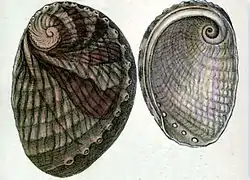| Haliotis australis | |
|---|---|
 | |
| Drawing with two views of a shell of Haliotis australis | |
| Scientific classification | |
| Domain: | Eukaryota |
| Kingdom: | Animalia |
| Phylum: | Mollusca |
| Class: | Gastropoda |
| Subclass: | Vetigastropoda |
| Order: | Lepetellida |
| Family: | Haliotidae |
| Genus: | Haliotis |
| Species: | H. australis |
| Binomial name | |
| Haliotis australis Gmelin, 1791 | |
| Synonyms[2] | |
| |
Haliotis australis, common name the queen pāua, yellowfoot pāua, or austral abalone, is a species of edible sea snail, a marine gastropod mollusk in the family Haliotidae, the abalones.[2][3]
Description
The size of the shell varies between 40 mm and 100 mm. "The thin, oval shell is quite convex. The distance of the apex from margin measures one-eighth to one-ninth the length of the shell. The sculpture consists of faint spirals and a close strong radiating corrugation. The 6 to 8 perforations are circular with elevated edges. The outlines are oval. The right margin is a little straighter. The back of the shell is convex, not carinated at the row of holes. The color pattern is light yellowish-brown, red on the spire, or light green flamed with red. The surface has almost obsolete spiral cords, and regular, close, radiating folds. Between the row of holes and the columellar margin there are no radiating folds, but several (generally three) strong spiral ribs. The spire is a little elevated and contains three whorls .Inside it is corrugated like the exterior, silvery with blue, green and red reflections, the latter predominating. The columellar plate is narrow.
The corrugated exterior is quite constant and characteristic. Young specimens are more strongly ribbed spirally, and often have radiating stripes of red on a delicate green ground."[4]
Distribution
It is endemic and found across New Zealand.[5][6]
Human use
Haliotis australis (also known as 'Queenies') and other two Haliotis species are known as "pāua" in New Zealand and are used as a food source. While generally smaller than their Haliotis iris counterparts, they are still harvested but must be a minimum length of 80mm.[7]
_from_New_Zealand.jpg.webp)
_Shells_(Interior)_New_Zealand.jpg.webp)
References
- ↑ Evans, H.J.N.; Peters, H. (2021). "Haliotis australis". IUCN Red List of Threatened Species. 2021: e.T78763353A78772398. doi:10.2305/IUCN.UK.2021-1.RLTS.T78763353A78772398.en.
- 1 2 WoRMS : Haliotis australis; accessed : 5 October 2010
- ↑ Industries, Ministry for Primary. "Pāua | MPI - Ministry for Primary Industries. A New Zealand Government Department". www.fisheries.govt.nz. Retrieved 2020-04-07.
- ↑ H.A. Pilsbry (1890) Manual of Conchology XII; Academy of Natural Sciences, Philadelphia, 1890 (described as Haliotis rugosoplicata)
- ↑ Oliver, A.P.H. (2004). Guide to Seashells of the World. Buffalo: Firefly Books. 22.
- ↑ "NZ Mollusca - Haliotis australis". www.mollusca.co.nz. Retrieved 2020-04-07.
- ↑ Industries, Ministry for Primary. "Pāua | MPI - Ministry for Primary Industries. A New Zealand Government Department". www.fisheries.govt.nz. Retrieved 2020-04-07.
- Geiger D.L. & Poppe G.T. (2000). A Conchological Iconography: The family Haliotidae. Conchbooks, Hackenheim Germany. 135pp 83pls.
- Geiger D.L. & Owen B. (2012) Abalone: Worldwide Haliotidae. Hackenheim: Conchbooks. viii + 361 pp. page(s): 72
External links
- photos
- "Haliotis (Sulculus) australis". Gastropods.com. Retrieved 16 January 2019.
